Marne la Vallée, France – Sunday, March 21st, 2010
Here I am, trapped inside my own body, my own mind, my own solipsistic little universe, where the only thing I can know for certain is that I exist; the external reality I think I am observing this moment is confusing, deceitful and potentially non-existent. And yet from those petty powers of internal logic it’s become indisputable that only that external material world that exists in any true capacity, meaning that even my own brain, my conception of self and personal identity, are nothing more than a complex assembly of lifeless, meaningless quantum bits and pieces, trapped without free-will in a chain of causal relations within space and time that can be traced back to the beginning of the universe with no hope for an exit or an answer. What an awful contradiction that is! Since I’m probably going to be wallowing in nihilistic despair for the next little while, I figure there’s no better place to contemplate the empty nothingness of existence than in the place that gave us Sartre and Camus.
That’s right, I’m going to Disneyland Paris.
I’ve never been to a Disney park before. I’ve simply never had any real interest. Part of it might just be because I’m outside of their target market, and without having been there earlier in my life, the sound of “it’s a small world” repeated endlessly doesn’t conjure happy childhood memories but teeth-grating annoyance. “The Happiest Place on Earth”? Come on, how can they advertise happiness like that, it’s not a commodity. The feeling I have is that Disney represents the backbone of a very shallow, materialistic view of human happiness that I want to avoid like the plague. It might also be political. The idea of giving money to a corporation as monolithic and as culturally imperialistic as Disney seems like a wrong use of my limited financial resources (and yes, I am using ‘wrong’ in the moral sense of the term). It could also just be that I perceive Disney as being too much fluff with not enough substance; sprawling, intricately themed sections consisting of all spectacles and gift shops, and then with only one or two real attractions actually worth paying admission for.
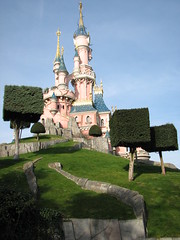 But I had a week off for spring break while studying in Rome, and after looking over my options for where I could travel during that week, Disney was one of the few that presented itself as even being open. As soon as I decided on Paris/Disney to spend my time, I immediately jumped onto Parc Astérix’s website to see if I could visit there as well. They were not open. Aw. “Honestly, if I could have a free choice between visiting Disneyland Paris and visiting Parc Astérix, I’d pick Astérix”. But as I said that, I stopped.
But I had a week off for spring break while studying in Rome, and after looking over my options for where I could travel during that week, Disney was one of the few that presented itself as even being open. As soon as I decided on Paris/Disney to spend my time, I immediately jumped onto Parc Astérix’s website to see if I could visit there as well. They were not open. Aw. “Honestly, if I could have a free choice between visiting Disneyland Paris and visiting Parc Astérix, I’d pick Astérix”. But as I said that, I stopped.
Really? Really, really? What does Parc Astérix actually have that’s of interest to me that Disneyland doesn’t? Tonnerre de Zeus, a middling CCI effort, and that’s it. After that all they have is Goudurix,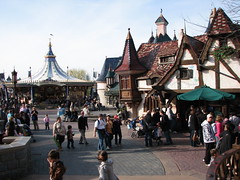 and if I want to ride a Vekoma MK-1200 then Disney has two of those, both themed and with more original layouts (and they’re not rated at the bottom of the Internet Steel Coaster Poll every year either). There’s two more themed family coasters which I could also get done much better at Disney. Not that I couldn’t still argue that Parc Astérix is maybe the superior park depending on the criteria you use to define the comparison, but my automatic preference of any standard amusement park over a Disney park without even weighing the pros and cons of each made me realize something: I had become irrationally prejudiced against anything Disney.
and if I want to ride a Vekoma MK-1200 then Disney has two of those, both themed and with more original layouts (and they’re not rated at the bottom of the Internet Steel Coaster Poll every year either). There’s two more themed family coasters which I could also get done much better at Disney. Not that I couldn’t still argue that Parc Astérix is maybe the superior park depending on the criteria you use to define the comparison, but my automatic preference of any standard amusement park over a Disney park without even weighing the pros and cons of each made me realize something: I had become irrationally prejudiced against anything Disney.
And so, on Sunday, March 21st, in the year two-thousand-ten, Anno Domini, with ticket clutched in palm and a walk of mild apprehension, I emerged through the gates of Disneyland Paris– and I was going to do my best to enjoy myself. Was I successful? We shall see…
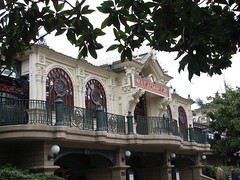 The day started off rather cold and overcast. I made my way down Main Street U.S.A. quickly thanks to the lack of anything interesting to divert my attention. It seemed my first reservation about visiting a Disney park was coming true: is there anything to actually do that doesn’t involve buying Mickey Mouse ears in different themed gift shops? I trust the American versions of Main Street U.S.A. have a bit more going for them since they don’t have the advantage of being in a country where this style of themeing is a bit foreign and exciting to the local population, but based on what I’ve seen I’m not so sure. The street cars weren’t anywhere to be seen, not that I’d really count public transport as a destination attraction anyway. It is an impressively constructed entry midway, although for a theme park that emphasizes the spectacle of fantasy it was a
The day started off rather cold and overcast. I made my way down Main Street U.S.A. quickly thanks to the lack of anything interesting to divert my attention. It seemed my first reservation about visiting a Disney park was coming true: is there anything to actually do that doesn’t involve buying Mickey Mouse ears in different themed gift shops? I trust the American versions of Main Street U.S.A. have a bit more going for them since they don’t have the advantage of being in a country where this style of themeing is a bit foreign and exciting to the local population, but based on what I’ve seen I’m not so sure. The street cars weren’t anywhere to be seen, not that I’d really count public transport as a destination attraction anyway. It is an impressively constructed entry midway, although for a theme park that emphasizes the spectacle of fantasy it was a  curious choice for the opening section to be given such a mundane and ordinary setting. That’s not to say it’s without purpose, since the original was meant to evoke the childhood hometown that Walt Disney grew up in. So it’s not only mundane, but also egocentric.
curious choice for the opening section to be given such a mundane and ordinary setting. That’s not to say it’s without purpose, since the original was meant to evoke the childhood hometown that Walt Disney grew up in. So it’s not only mundane, but also egocentric.
 No! Bad coaster philosopher! I promised myself I’d check my cynicism at the main gates, and look at what I’m doing barely five minutes into the park. I should try to enjoy the full day’s experience free of any prejudices and only after it’s over can I be allowed to start applying my usual critical analysis. Okay, so I’m at the end of Main Street USA and my plan is to go left to make Big Thunder Mountain my official first Disney roller coaster, which I’ve heard good things about. But I forgot to pick up a park map at the front gate, so I stop at a small info point to pick one up and notice a handy list of wait times for attractions throughout the park, Big Thunder listed as having nearly an hour long wait. Just below it I see the Indiana Jones coaster is posting less than 10 minutes, so I figure in a change in plans to stop through Frontierland quickly to pick up a fast pass for Big Thunder, then move onto explore Adventureland.
No! Bad coaster philosopher! I promised myself I’d check my cynicism at the main gates, and look at what I’m doing barely five minutes into the park. I should try to enjoy the full day’s experience free of any prejudices and only after it’s over can I be allowed to start applying my usual critical analysis. Okay, so I’m at the end of Main Street USA and my plan is to go left to make Big Thunder Mountain my official first Disney roller coaster, which I’ve heard good things about. But I forgot to pick up a park map at the front gate, so I stop at a small info point to pick one up and notice a handy list of wait times for attractions throughout the park, Big Thunder listed as having nearly an hour long wait. Just below it I see the Indiana Jones coaster is posting less than 10 minutes, so I figure in a change in plans to stop through Frontierland quickly to pick up a fast pass for Big Thunder, then move onto explore Adventureland.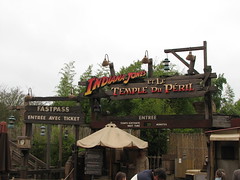
So, first ride to review: Indiana Jones et le Temple du Péril. As promised, there was barely a five minute wait for this attraction. I suspect this probably was a bad choice to make my inaugural Disney experience, but it may have ultimately been for the best,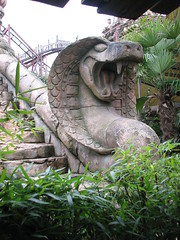 being the single attraction in the park with strong roots in the traditional amusement park attraction milieu. For reasons beyond any rational comprehension, Disney asked Intamin to design for them a Pinfari Looping Star rip-off, complete with coffin-like ride vehicles, which they could then somehow theme to the Indiana Jones franchise. The themeing is almost impressive in places, but then I realized they didn’t touch the lattice support structures besides integrating some basic temple structures inside the turns (rather than enclosing/obscuring them), and the whole thing does come off as a cheap theme park attraction. I got placed in the front seat, the trains quickly hurried out of the dual loading station, and after a slight pause on the block just around the first station turn to wait for the previous train to clear the lift, we were off up to the top.
being the single attraction in the park with strong roots in the traditional amusement park attraction milieu. For reasons beyond any rational comprehension, Disney asked Intamin to design for them a Pinfari Looping Star rip-off, complete with coffin-like ride vehicles, which they could then somehow theme to the Indiana Jones franchise. The themeing is almost impressive in places, but then I realized they didn’t touch the lattice support structures besides integrating some basic temple structures inside the turns (rather than enclosing/obscuring them), and the whole thing does come off as a cheap theme park attraction. I got placed in the front seat, the trains quickly hurried out of the dual loading station, and after a slight pause on the block just around the first station turn to wait for the previous train to clear the lift, we were off up to the top.
A slow curve at the top lead into one small dip, leading into a second slightly-less-slow flat turn before another quick dip. The ride has a reputation for being a real headbanger, and given the configuration of the cars it’s not hard to see why, but I’m not having any real problems so far. After a third flat turn there’s a long straight stretch of track with a small block at the end, feeding a spiraling drop feeding directly into a 360 loop. This is actually rather intense (likely due to the nearly circular shaping), the positives around the loop really start to distort my perception, and the whole lead-up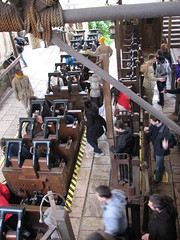 to this moment does an adequate job at crafting anticipation. Afterward the ride is more or less a dud as it tools around with some pointless hills and a few helices that start to build to something before giving up. By the last turn when the train enters the brakes I’m thinking that wasn’t mind-bending, but it seemed a reliable little coaster ride I
to this moment does an adequate job at crafting anticipation. Afterward the ride is more or less a dud as it tools around with some pointless hills and a few helices that start to build to something before giving up. By the last turn when the train enters the brakes I’m thinking that wasn’t mind-bending, but it seemed a reliable little coaster ride I  could do whenever I got bored with the show attractions and the other two in the park had too long of lines; I even took the time to get an immediate re-ride while I was there as the wait was even shorter when I got back. Does anyone have any feedback on how this ride was when it was configured to run in reverse? I remember watching a television special on this one a while ago about how when they reversed the cars from 2000 to 2004 they had to redesign the themed edifices so that way riders couldn’t see any of the backstage. My question is: where? The train doesn’t actually travel through any sets, like I said there’s just some basic structures built in and around the coaster but otherwise they’ve still left the ride system mostly exposed. Later when I came back to this attraction I was even less impressed; at first not having a point of context with other Disney rides made me an easier judge, which is why I said it was perhaps a good thing I made this my first ride of the day.
could do whenever I got bored with the show attractions and the other two in the park had too long of lines; I even took the time to get an immediate re-ride while I was there as the wait was even shorter when I got back. Does anyone have any feedback on how this ride was when it was configured to run in reverse? I remember watching a television special on this one a while ago about how when they reversed the cars from 2000 to 2004 they had to redesign the themed edifices so that way riders couldn’t see any of the backstage. My question is: where? The train doesn’t actually travel through any sets, like I said there’s just some basic structures built in and around the coaster but otherwise they’ve still left the ride system mostly exposed. Later when I came back to this attraction I was even less impressed; at first not having a point of context with other Disney rides made me an easier judge, which is why I said it was perhaps a good thing I made this my first ride of the day.
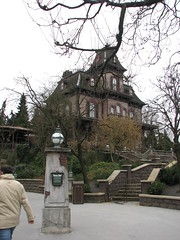 Wandering back to Frontierland, I still had plenty of extra time left on my fast pass so I decided to see what else this themed section has. One of the other main attractions of interest to me was Phantom Manor, the park’s western-inspired take on the classic Haunted Mansion dark ride. The wait for this one was less than 20 minutes, and it moved fast. I was a bit disappointed to find that the queue was housed in a basic switchback structure under a canopy not unlike what I’d find at a standard theme park, but once inside the manor things became more interesting. As a group we were led into a small anteroom, where the attendant’s real performance was in juggling both French
Wandering back to Frontierland, I still had plenty of extra time left on my fast pass so I decided to see what else this themed section has. One of the other main attractions of interest to me was Phantom Manor, the park’s western-inspired take on the classic Haunted Mansion dark ride. The wait for this one was less than 20 minutes, and it moved fast. I was a bit disappointed to find that the queue was housed in a basic switchback structure under a canopy not unlike what I’d find at a standard theme park, but once inside the manor things became more interesting. As a group we were led into a small anteroom, where the attendant’s real performance was in juggling both French and English during the introduction while trying to stay in character. At first I didn’t think too much of this room (is this really supposed to be the extreme attention to detail I hear about from Disney? They just duplicated the same basic construction materials on each side of the wall), but then the preshow started up and… it was an interesting effect to say the least. I’m generally not one to care about spoilers that much, but the impression of this preshow was due largely to my not expecting it, so I’ll leave that as one of the few mysteries for other readers to discover (not that a quick search on Wikipedia couldn’t reveal the effect for anyone instead). Another caveat to these preshows is everyone in line gets mixed up in the same room before exiting it again to board the ride vehicles, so if you just managed to be one of the last ones to be let in, you can probably edge your way along toward the exit door during the show and effectively line jump fifty people or so. Not that I’m recommending that as at all ethical behavior.
and English during the introduction while trying to stay in character. At first I didn’t think too much of this room (is this really supposed to be the extreme attention to detail I hear about from Disney? They just duplicated the same basic construction materials on each side of the wall), but then the preshow started up and… it was an interesting effect to say the least. I’m generally not one to care about spoilers that much, but the impression of this preshow was due largely to my not expecting it, so I’ll leave that as one of the few mysteries for other readers to discover (not that a quick search on Wikipedia couldn’t reveal the effect for anyone instead). Another caveat to these preshows is everyone in line gets mixed up in the same room before exiting it again to board the ride vehicles, so if you just managed to be one of the last ones to be let in, you can probably edge your way along toward the exit door during the show and effectively line jump fifty people or so. Not that I’m recommending that as at all ethical behavior.
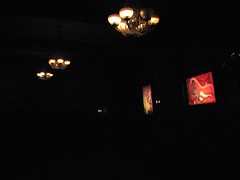 Another small corridor past several ‘illusory’ paintings (using the same technology any child with a special edition bubble gum card should be familiar with) we arrive at the vehicle loading platform. It’s a continuously moving chain of vehicles (Wikipedia also tells me these are officially called “Doom Buggies”), which is both practical from a capacity standpoint but a bit disappointing from a ride quality standpoint; besides there constantly being other vehicles around you that occasionally obstruct your view, it means that there can’t be any set pieces that individually convey some sort narrative directly to the riders (i.e. even simple things such as entering a dark room in which a ghost suddenly jumps out at you), it must consist entirely of moving past scenes that are on a continuous loop so every vehicle experiences the same thing. Resultantly,
Another small corridor past several ‘illusory’ paintings (using the same technology any child with a special edition bubble gum card should be familiar with) we arrive at the vehicle loading platform. It’s a continuously moving chain of vehicles (Wikipedia also tells me these are officially called “Doom Buggies”), which is both practical from a capacity standpoint but a bit disappointing from a ride quality standpoint; besides there constantly being other vehicles around you that occasionally obstruct your view, it means that there can’t be any set pieces that individually convey some sort narrative directly to the riders (i.e. even simple things such as entering a dark room in which a ghost suddenly jumps out at you), it must consist entirely of moving past scenes that are on a continuous loop so every vehicle experiences the same thing. Resultantly, 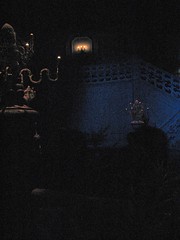 Phantom Manor really can’t be ‘scary’ or even ‘suspenseful’, only convey a sense of atmosphere and setting. But okay; F.W. Murnau’s Nosferatu or Stanley Kubrick’s The Shining adhered to those same principles, and those are possibly two of the greatest horror films ever committed to celluloid.
Phantom Manor really can’t be ‘scary’ or even ‘suspenseful’, only convey a sense of atmosphere and setting. But okay; F.W. Murnau’s Nosferatu or Stanley Kubrick’s The Shining adhered to those same principles, and those are possibly two of the greatest horror films ever committed to celluloid.
Honestly I can’t remember the sequence of every effect in Phantom Manor, nor do I recall the precise sequence as being particularly important. There’s a loose story involving a bride, who we see at the beginning as an animatronic happily singing, but then some sort of tragedy befalls her as spirits take over the Manor, and by the end she becomes a living corpse, which is the sort of conclusion you’d expect from a ride called Phantom Manor, so not much dialogue is needed to explain this connection. Toward the end we are also randomly taken through a wild west ghost town scene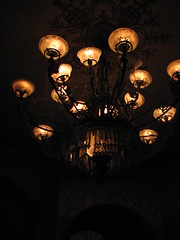 which I’m not sure how it really fits in with the rest of the ride besides to establish it as being the Frontierland version of the Haunted Mansion. The main interest is in marveling at the technological special effects wizardry at work in there. I already mentioned the preshow room, but with the numerous holograms (crystal ball, ride-a-long ghosts, and the famous ballroom scene literally had me leaning over the ride vehicle to try to figure out how the heck they did that) I was quite impressed. That said, I feel that these effects actually compromised the establishment of any foreboding sense of atmosphere the ride should achieve. With so much happening at every corner that commands a moment’s attention, I felt busy and overworked to make sure I could see everything I was supposed to rather than given an opportunity to sit back and revel in the Grand Guignol suspense. That is, there are so many details rendering it impossible to appreciate the larger picture. I can clearly see why these Disney attractions inspire such huge fanbases, but for me personally, Nights in White Satin: The Trip will remain nearest and dearest to my heart.
which I’m not sure how it really fits in with the rest of the ride besides to establish it as being the Frontierland version of the Haunted Mansion. The main interest is in marveling at the technological special effects wizardry at work in there. I already mentioned the preshow room, but with the numerous holograms (crystal ball, ride-a-long ghosts, and the famous ballroom scene literally had me leaning over the ride vehicle to try to figure out how the heck they did that) I was quite impressed. That said, I feel that these effects actually compromised the establishment of any foreboding sense of atmosphere the ride should achieve. With so much happening at every corner that commands a moment’s attention, I felt busy and overworked to make sure I could see everything I was supposed to rather than given an opportunity to sit back and revel in the Grand Guignol suspense. That is, there are so many details rendering it impossible to appreciate the larger picture. I can clearly see why these Disney attractions inspire such huge fanbases, but for me personally, Nights in White Satin: The Trip will remain nearest and dearest to my heart.
 Still with a bit more time to spare before Big Thunder Mountain was up, I hopped on the Thunder Mesa Riverboat Landing to see what there was to see around the Frontierland lagoon. The answer: Big Thunder Mountain from all angels, and that’s pretty much all. They did a nice job filling the surrounding landscape with North American scenery, although it didn’t occur to me until nearly halfway through the cruise how ‘exotic’ this landscape might appear to a Parisian. I believe there was supposed to be a geyser show near the end of the ride that was also not functioning on my day there.
Still with a bit more time to spare before Big Thunder Mountain was up, I hopped on the Thunder Mesa Riverboat Landing to see what there was to see around the Frontierland lagoon. The answer: Big Thunder Mountain from all angels, and that’s pretty much all. They did a nice job filling the surrounding landscape with North American scenery, although it didn’t occur to me until nearly halfway through the cruise how ‘exotic’ this landscape might appear to a Parisian. I believe there was supposed to be a geyser show near the end of the ride that was also not functioning on my day there.  It’s a nice riverboat replica they have built, but I couldn’t help but feel that the whole excursion was ultimately lacking any real purpose other than as an extended photo opportunity. They also do a good job masking the fact that it rolls along on an underwater track, but it’s still rather obvious if you think about it and that still removed the ride a bit of its authenticity.
It’s a nice riverboat replica they have built, but I couldn’t help but feel that the whole excursion was ultimately lacking any real purpose other than as an extended photo opportunity. They also do a good job masking the fact that it rolls along on an underwater track, but it’s still rather obvious if you think about it and that still removed the ride a bit of its authenticity.
Finally, my scheduled return time for Big Thunder Mountain was ready. I picked up another fast pass which was now available and found the entrance to the attraction. With dual stations and a blocking setup capable of handling five 30-passenger trains at a single time, I was loaded into my back seat ride with efficient timing. Taking off from the station we quickly accelerate downhill, underneath the lake to arrive at the first lift hill, enclosed in a large cavern filled with plaster stalagmites and stalactites. We exit this chamber at the top and make a descending left turn. The first part of the layout is rather awkward, meandering from one edge of the mountain and then back, lots of straight track with small kinks in them to navigate around the scenery. 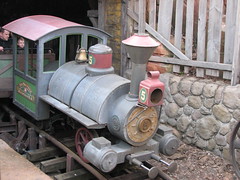 My suspicion is that the mountain was designed as the first priority, the placement of the lifts second, and the track was built to fit between those elements most effortlessly. Banking transitions and the overall geometry to the trackwork also suggests a ride much older than one built in 1992, with hard, non-heartlined prebanks leading from circular flat curves and lots of straight track separating these individual maneuvers, but it’s fitting for the style of ride and gives it more character than the more recent approach to mine trains built by Vekoma. It maintains a mostly downhill route, dodging under an opossum hanging from a tree, before diving to a river splashdown (minus the splash) and with the grind of a set of anti-rollbacks the train rolls around a left turn to engage the second lifthill.
My suspicion is that the mountain was designed as the first priority, the placement of the lifts second, and the track was built to fit between those elements most effortlessly. Banking transitions and the overall geometry to the trackwork also suggests a ride much older than one built in 1992, with hard, non-heartlined prebanks leading from circular flat curves and lots of straight track separating these individual maneuvers, but it’s fitting for the style of ride and gives it more character than the more recent approach to mine trains built by Vekoma. It maintains a mostly downhill route, dodging under an opossum hanging from a tree, before diving to a river splashdown (minus the splash) and with the grind of a set of anti-rollbacks the train rolls around a left turn to engage the second lifthill.
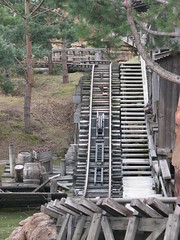 This one takes place all outdoors, with a few anamatronic mules and other critters providing something to look at as we wait for the ride to start up again. I will reiterate this point: the anti-rollbacks are loud,
This one takes place all outdoors, with a few anamatronic mules and other critters providing something to look at as we wait for the ride to start up again. I will reiterate this point: the anti-rollbacks are loud,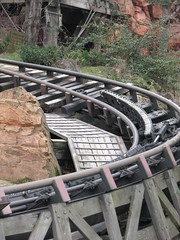 especially at the top of the lift. Not quite Son of Beast loud, but they might be a runner-up for that contention. I would figure this would be something Disney would want to silence but evidently not. Off the top of this second (and I believe tallest) lift we have another descending left turn, and after some more angular hill transitions is followed up with a counter-clockwise 540° helix. It bucks up, dives down for a nice headchopper effect with a canyon tunnel, and makes a right turn over the lake into another mine shaft to engage in lift number three, which simulates a dynamite explosion with the track even tilting back and forth slightly as the train climbs upward (not too much that the chain dog would disengage with the chain, obviously).
especially at the top of the lift. Not quite Son of Beast loud, but they might be a runner-up for that contention. I would figure this would be something Disney would want to silence but evidently not. Off the top of this second (and I believe tallest) lift we have another descending left turn, and after some more angular hill transitions is followed up with a counter-clockwise 540° helix. It bucks up, dives down for a nice headchopper effect with a canyon tunnel, and makes a right turn over the lake into another mine shaft to engage in lift number three, which simulates a dynamite explosion with the track even tilting back and forth slightly as the train climbs upward (not too much that the chain dog would disengage with the chain, obviously).
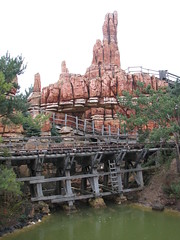 So far it’s had an odd pacing structure– pause for a lift, roll mostly downhill with a syncopated stop-start collection of quick turns and drops while it gets halfway there with the speed gained, before stopping for another lift. It’s probably more a necessity of running this many trains when a lifthill block is needed every 30 seconds or so, and consequently the height differences can’t be too great either. However, this final part is where the ride starts to pay off. The second section was just a bit more intense and involved than the first, and with this section it takes that formula
So far it’s had an odd pacing structure– pause for a lift, roll mostly downhill with a syncopated stop-start collection of quick turns and drops while it gets halfway there with the speed gained, before stopping for another lift. It’s probably more a necessity of running this many trains when a lifthill block is needed every 30 seconds or so, and consequently the height differences can’t be too great either. However, this final part is where the ride starts to pay off. The second section was just a bit more intense and involved than the first, and with this section it takes that formula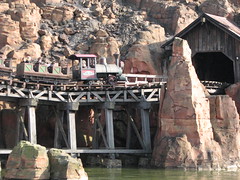 of slight downhill with a lot of odd turns and dips thrown in, cuts out the excess hops and helices diversions, and makes it just one long, continuous descent, first down a left turn, accumulating a decent amount of speed on the runway, then with a final quick scoot to the left it enter the final tunnel. After a quick bat scene, everything turns pitch black, our cars angle even steeper downhill, the air temperature suddenly dropping, and we just keep going down… and down… and down…
of slight downhill with a lot of odd turns and dips thrown in, cuts out the excess hops and helices diversions, and makes it just one long, continuous descent, first down a left turn, accumulating a decent amount of speed on the runway, then with a final quick scoot to the left it enter the final tunnel. After a quick bat scene, everything turns pitch black, our cars angle even steeper downhill, the air temperature suddenly dropping, and we just keep going down… and down… and down…
Holy crap, this is actually kind of awesome!
 The first time through especially, this drop really grabbed hold and shook me hard, and it remained a great highlight no matter how many more times I ventured on board. At maximum speed under the lake, there’s a fast, sharply banked left turn in the pitch black. An uphill climb returns us to the surface level back on the mainland, the anti-rollbacks again grinding with a small lift giving the long train enough momentum to get up into the final brake run. We make the bend around a small turn, and I exit the station, actually impressed by Big Thunder Mountain.
The first time through especially, this drop really grabbed hold and shook me hard, and it remained a great highlight no matter how many more times I ventured on board. At maximum speed under the lake, there’s a fast, sharply banked left turn in the pitch black. An uphill climb returns us to the surface level back on the mainland, the anti-rollbacks again grinding with a small lift giving the long train enough momentum to get up into the final brake run. We make the bend around a small turn, and I exit the station, actually impressed by Big Thunder Mountain.
To throw a bit of criticism into the pot (c’mon, no ride gets away from me that easily), I do feel like the animatronics and other show effects along the layout don’t add much to the ride experience. Like Phantom Manor, the excessive attention to detail by putting if anything serves to distract rather than add to the experience, and while the animatronics are well-crafted, being still obviously fake they only highlight the artificiality of the entire experience (oops, I’m getting ahead of myself, that’s a discussion for another time…)
 Also, as much as I enjoyed Big Thunder Mountain in Paris, I’m unsure what my reaction would be to its counterparts on different continents. The thing that really made the ride for me was the finale with the long drop underneath the lake, which put into context the rest of the ride which was not much more than gentle meandering downhill. This gave the overall experience a narrative that would cycle through building and releasing tension several times before ending it with the continuous downhill climax
Also, as much as I enjoyed Big Thunder Mountain in Paris, I’m unsure what my reaction would be to its counterparts on different continents. The thing that really made the ride for me was the finale with the long drop underneath the lake, which put into context the rest of the ride which was not much more than gentle meandering downhill. This gave the overall experience a narrative that would cycle through building and releasing tension several times before ending it with the continuous downhill climax after the third lift, but without that last section I’m not sure how I’d reinterpret the ride. And none of the other versions have that finale, although I’ve not seen POVs of them so I don’t know what they have in place. Regardless, every other review I’ve read has nearly unanimously expressed the opinion that the Paris version is by far the best, so as much as I enjoyed this Big Thunder Mountain, my motivation to check out the others isn’t much improved from before.
after the third lift, but without that last section I’m not sure how I’d reinterpret the ride. And none of the other versions have that finale, although I’ve not seen POVs of them so I don’t know what they have in place. Regardless, every other review I’ve read has nearly unanimously expressed the opinion that the Paris version is by far the best, so as much as I enjoyed this Big Thunder Mountain, my motivation to check out the others isn’t much improved from before.
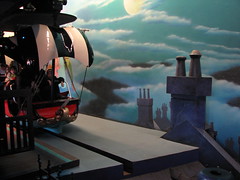 After Big Thunder Mountain, I went on to explore the rest of the park, sampling other E-Ticket attractions Pirates of the Caribbean and Space Mountain, but since I have a second day at Disneyland Paris to report on I will save detailed reviews of those until then. A couple of other minor rides I did try this first day included Peter Pan’s Flight in Fantasyland, which is basically a retelling of the movie in a dark ride set-up (this one with some nifty suspended cars that allow us to ‘fly’ over a miniature London). However, as dark rides aren’t that adept at communicating narratives of any particular depth, I suspect the ride banks heavily on the expectation that those that ride it are already familiar with the story. But if that’s the case, why the need to just repeat the same thing only in five minutes and without dialogue or characterization?
After Big Thunder Mountain, I went on to explore the rest of the park, sampling other E-Ticket attractions Pirates of the Caribbean and Space Mountain, but since I have a second day at Disneyland Paris to report on I will save detailed reviews of those until then. A couple of other minor rides I did try this first day included Peter Pan’s Flight in Fantasyland, which is basically a retelling of the movie in a dark ride set-up (this one with some nifty suspended cars that allow us to ‘fly’ over a miniature London). However, as dark rides aren’t that adept at communicating narratives of any particular depth, I suspect the ride banks heavily on the expectation that those that ride it are already familiar with the story. But if that’s the case, why the need to just repeat the same thing only in five minutes and without dialogue or characterization?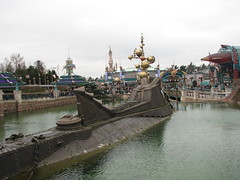 I could give an answer to that, but I promised myself I would just enjoy the park without any cynical analysis of the corporate Disney Empire and I’m going to continue with that trend until I’m outside the gates in the last part of this series of reports.
I could give an answer to that, but I promised myself I would just enjoy the park without any cynical analysis of the corporate Disney Empire and I’m going to continue with that trend until I’m outside the gates in the last part of this series of reports.
Over in Discoveryland were attractions such as Les Mystères du Nautilus and Star Tours, both of which I rate with a resounding “meh”. In particular the Nautilus attraction was a low point; supposedly it should be an underwater tour, but as far as I could tell it might have well taken place in a set in someone’s garage as there were no portholes with the outside environment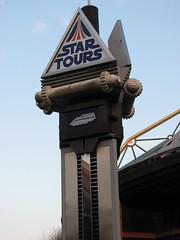 save for maybe one with a squid anamatronic, which was easily the highlight of the entire attraction. The rest was just narrow corridors with occasional science-fiction props inspired by 20,000 Leagues Under the Sea, and while it might have made a decent queue line for some other attraction, by itself I just had to ask “what’s the point”? Thankfully since it’s just a walk-through attraction there’s no line for it. Star Tours was slightly better, but then I’ve never been a fan of rides that lock you in a box with a video screen at the front and bounce you around for a few minutes under the pretense that they’re telling a ‘story’. It starts out as a supposed tour of the Star Wars universe, but very quickly veers off into that all-too familiar theme park narrative of “something has gone horribly wrong which we’ll use as an excuse to set the ride’s program to ‘paint mixer’ for several minutes”. We quickly recapitulate the ending of Episode IV (only again, without the dialogue or characterization), and then return back to the base. A live-action droid in front of the ship provided commentary during the tour, but this was all in French so I couldn’t very well keep up.
save for maybe one with a squid anamatronic, which was easily the highlight of the entire attraction. The rest was just narrow corridors with occasional science-fiction props inspired by 20,000 Leagues Under the Sea, and while it might have made a decent queue line for some other attraction, by itself I just had to ask “what’s the point”? Thankfully since it’s just a walk-through attraction there’s no line for it. Star Tours was slightly better, but then I’ve never been a fan of rides that lock you in a box with a video screen at the front and bounce you around for a few minutes under the pretense that they’re telling a ‘story’. It starts out as a supposed tour of the Star Wars universe, but very quickly veers off into that all-too familiar theme park narrative of “something has gone horribly wrong which we’ll use as an excuse to set the ride’s program to ‘paint mixer’ for several minutes”. We quickly recapitulate the ending of Episode IV (only again, without the dialogue or characterization), and then return back to the base. A live-action droid in front of the ship provided commentary during the tour, but this was all in French so I couldn’t very well keep up.
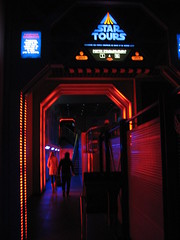 But honestly I think riding it in English would be even less rewarding because that was by far one of the most interesting things I found at Disneyland Paris that made my visit worthwhile: the difference in cultures. I’m not just talking about being in a different culture; if I wanted that I was about 30 miles too far east. It was observing the way Disney tried to manage the fact that they were attracting a clientele that spoke many different languages in a way not really found at other amusement parks, if anywhere. It’s not even a case like in the city, where obviously French is the dominant language but plenty accommodations are available for foreign tourists. At Disney, everyone was on equal ground. We were all tourists visiting someplace that was not quite home (for the French, it was an Anglo-American experience, for the Brits, it was a French experience) demanding that the park adjust to their own culture while at the same time marveling at the foreign ‘otherness’ of the experience. It wasn’t just the French-English contrast either, plenty of German, Spanish and Italians were also present, which made for some decently interesting people-watching in the queues.
But honestly I think riding it in English would be even less rewarding because that was by far one of the most interesting things I found at Disneyland Paris that made my visit worthwhile: the difference in cultures. I’m not just talking about being in a different culture; if I wanted that I was about 30 miles too far east. It was observing the way Disney tried to manage the fact that they were attracting a clientele that spoke many different languages in a way not really found at other amusement parks, if anywhere. It’s not even a case like in the city, where obviously French is the dominant language but plenty accommodations are available for foreign tourists. At Disney, everyone was on equal ground. We were all tourists visiting someplace that was not quite home (for the French, it was an Anglo-American experience, for the Brits, it was a French experience) demanding that the park adjust to their own culture while at the same time marveling at the foreign ‘otherness’ of the experience. It wasn’t just the French-English contrast either, plenty of German, Spanish and Italians were also present, which made for some decently interesting people-watching in the queues.
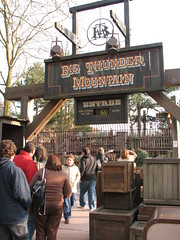 The rides are generally designed for both French and English speakers but then sometimes there would be odd choices over which language became the dominating one: some were evenly split between French and English whenever there was a script in part of the ride, some leaned heavily towards French (Star Tours or Indiana Jones, despite being based on English-language franchises) while others seemed to favor English when they had themes that should have been language-neutral. Hearing the French guests attempt to pronounce “Space Mountain” or “Big Thunder Mountain” all day, I had to wonder if they actually knew what these names translate to.
The rides are generally designed for both French and English speakers but then sometimes there would be odd choices over which language became the dominating one: some were evenly split between French and English whenever there was a script in part of the ride, some leaned heavily towards French (Star Tours or Indiana Jones, despite being based on English-language franchises) while others seemed to favor English when they had themes that should have been language-neutral. Hearing the French guests attempt to pronounce “Space Mountain” or “Big Thunder Mountain” all day, I had to wonder if they actually knew what these names translate to.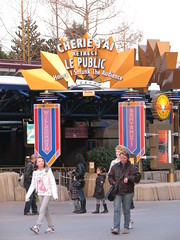 Actually, considering that the French term for “Roller Coaster” literally translates to “Russian Mountain”, the naming of the Disney coasters could probably make even more sense in Paris than it does in Orlando or Anaheim, if only Disney had given them monikers in the local language. I do appreciate that in locations such as Frontierland or Main Street USA, most of the themed signs and props were as they would appear in English rather than unrealistically translated into French; that always bothers me in movies or theme parks where everything’s in English even though they’re pretending it’s not, and I expect the same going the other direction. (Ratatouille, anyone? I was in Vienna later this week so I’ll list Amadeus is another major offender, to the point that it almost ruined my enjoyment of what otherwise would have been a great movie. Hopefully after the success Inglourious Basterds more directors will be conscious of this stuff.)
Actually, considering that the French term for “Roller Coaster” literally translates to “Russian Mountain”, the naming of the Disney coasters could probably make even more sense in Paris than it does in Orlando or Anaheim, if only Disney had given them monikers in the local language. I do appreciate that in locations such as Frontierland or Main Street USA, most of the themed signs and props were as they would appear in English rather than unrealistically translated into French; that always bothers me in movies or theme parks where everything’s in English even though they’re pretending it’s not, and I expect the same going the other direction. (Ratatouille, anyone? I was in Vienna later this week so I’ll list Amadeus is another major offender, to the point that it almost ruined my enjoyment of what otherwise would have been a great movie. Hopefully after the success Inglourious Basterds more directors will be conscious of this stuff.)
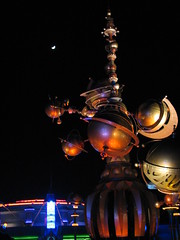 However, it was the employees where this melding of cultures became most intriguing (“cast members” is the official name for them, but I’m not going to call them that, c’mon, they’re just employees like anywhere else). Most of the major themed attractions generally involved giving some sort of live performance to introduce guests to the ride and remind them of the safety procedures, but with no common language among the participates, they had to do an incredible job juggling between French and English in a timely and efficient manner… all while staying in character as if it were a single monologue. It was nice for me because it meant I could take a break from constantly having to ask “English?” before asking a question or placing an order, although I do feel bad for the employees that they have to be always conscious of this during their daily jobs. Shortly after I got back I read this news story on how a string of Disneyland Paris employees were committing suicide rather than face work, and while it’s horrible to read, part of me is also not all that surprised. Coming full circle to my opening paragraph, it appears Albert Camus may have been correct when he stated the first and most important question anyone should ask of themselves is (and I’m paraphrasing), “should I kill myself, or ride Big Thunder Mountain?”
However, it was the employees where this melding of cultures became most intriguing (“cast members” is the official name for them, but I’m not going to call them that, c’mon, they’re just employees like anywhere else). Most of the major themed attractions generally involved giving some sort of live performance to introduce guests to the ride and remind them of the safety procedures, but with no common language among the participates, they had to do an incredible job juggling between French and English in a timely and efficient manner… all while staying in character as if it were a single monologue. It was nice for me because it meant I could take a break from constantly having to ask “English?” before asking a question or placing an order, although I do feel bad for the employees that they have to be always conscious of this during their daily jobs. Shortly after I got back I read this news story on how a string of Disneyland Paris employees were committing suicide rather than face work, and while it’s horrible to read, part of me is also not all that surprised. Coming full circle to my opening paragraph, it appears Albert Camus may have been correct when he stated the first and most important question anyone should ask of themselves is (and I’m paraphrasing), “should I kill myself, or ride Big Thunder Mountain?”
I forgot one last story from the first day I wanted to tell. So, sometime around when I did Star Tours, pretty much everyone abandoned the park. When I got off I found there were nearly walk-on lines for everything, so I did Space Mountain about four or five times, Indiana Jones three times, Big Thunder Mountain four times, Phantom Manor once, and then back to Space Mountain for three more rides all in a period of about 2 1/2 hours or so, and all in the dark. Definitely one of the highlights of the entire trip, at least the Disney portion of it. Big Thunder in particular was great at night, the tunnels turned pitch black the moment you entered them and the entire environment just seemed better.
Sounds like what I remember so far. The continuous downhill climax of Big Thunder Mountain sounds cool. I never found anything from my one trip to Disney World to be particularly memorable. Everything was just good. The ballroom scene in the Haunted Manor was probably the most memorable now that I’m thinking. I don’t think I would be able to enjoy myself there as an adult. My chiropractor thinks it’s the greatest thing though and his first trip was last year. The happy memories seem to be very authentic for him. He’s going back soon, this time with his parents. I don’t really get it. I loved the link to the string of suicides. That made me smile.
Okay – you do remember that we took you to Epcot, right, and last I checked that was a Disney park. The problem with taking you to Disney as a child is that your ride taste matured WAY too quickly. By the age where you were tall enough to ride everything it was too late, you would have been truly bored. I hope you don’t scar your children in the same way! Kidding.
Yes, I was going to put that in there, but I found that, rhetorically, writing “I’ve never been to a Disney park, except for one visit to Epcot many years ago” didn’t flow as well and didn’t particularly change the content of the message either. Especially because Epcot is sort of out there on it’s own in terms of Disney parks, they don’t even have any rides in the traditional sense. It was not having done any of the original Disneyland/Magic Kingdom parks until now that was important, and actually I was rather proud of that fact and disappointed I finally had to tarnish my record this year.
I knew what you meant and agree that the Epcot reference would have just cluttered the point. I was just trying to assuage some parental guilt that we were only taking you to CP, KI, g\SF, BG-W and BG-A, US instead.
And though you may feel a bit wistful that you gave in to the allure of Mickey and the gang – I hope you can embrace your new maturity as you are no longer a Disney virgin!! Add another notch on your belt!
Mr. C.P.
You have an extremely entertaining Blog/Review of the Paris Parks. I’m an Ex-Cast Member from WDW and will be visiting DLPR in 3 weeks for my second time. I consider myself a Disney enthusiast and have grown up with Disney as part of my culture. Your reviews are certainly a different perspective on the Disney Parks and I had to laugh when I was getting angry at some of your comments. You have a gift of being eloquently descriptive even when it’s slightly, err, extremely jaded. I say this with the utmost respect because everything you say is true, depending on your point of view. I don’t live in “Fantasyland” but I do suppose I have drunk from the Koolaid.
I truly appreciated your point of view and highly suggest you consider posting additional series of Blogs or Reviews. Start with the Walt Disney World Property in Orlando, Florida because there are so many different opportunities for you to experience in WDW that truly don’t compare to any of the other Disney properties. Don’t get me wrong here, the Disneyland Paris Park, in my opinion, is one of the most beautiful parks around the world (only second to Tokyo Disney Sea). Please consider visiting additional Disney Parks around the world and give them another go.
As for me, I’m fortunate there are people in this world who enjoy the silly and obnoxious happiness that can be life. We all as individuals choose how to spend this very short journey and I choose to be a kind, strong-willed personality who hopes some ill-fortune will not befall me for the sake of everyone else around. The concept of behaving like a real human being, with the proper amounts of depression, doubt and self-loathing sounds purely ludacris and hope to never experience such a thing.
Safe travels and I personally hope to read more of your experiences real soon. Take care.
-J.J.
Fort Lauderdale, FL
07-13-10
The post-modern cynicism towards It’s a Small World was intended to be taken too far, the contrast between the two viewpoints was meant for comedic effect. For the most part I understand why people like the ride and don’t begrudge them their reasons, and I certainly am not the kind of individual that would in real life begrudge anyone for any legitimate happiness. Which is why I turned the analysis around at one point and questioned “why cynicism towards happiness?” The one part where I was writing honest criticism against an arbitrarily happy ride like It’s a Small World was the last paragraph about the attraction; ignore the stuff before it and reread that section and hopefully you’ll understand my position a bit better.
The one Disney park I have the most immediate interest in visiting is the original Disneyland, but I suspect that is more for historical reasons (i.e. Matterhorn bobsleds). For whatever reason, Florida’s Magic Kingdom doesn’t have as much interest to me, as the qualities I enjoyed most about DLP (integration of European culture, larger and more intense coasters, plenty of small side pathways to explore off the main-midways) I don’t think I can find in Florida.
Edit: I also just want to add that it’s comments such as yours that keep me wanting to write more. Thanks for replying. 🙂
Interesting perspective. Although I am a Disney fanboy and also found my anger raising a bit reading the post, I thought I would perhaps lend a different perspective since I am also a major coaster fan (who makes a strong distinction between Disney parks and other parks).
Many people I talk to who made their first Disney trip later in life have similar perspectives. They have the notion of Disney attention to detail and a lack of real thrills. But, the “happiest place on earth” moniker functions in a much different way to me. At its heart, the problem is that you cannot experience happiness like this as an adult (not meaning that personally – but the inability as an adult). You are seeking reality. Amusement parks give you real thrills. A bigger ride will give you more of it – so you start craving bigger rides or more impressive layouts. There are always exceptions, but that general rule applies. The same with your special effects in films, food, etc. You also know what is impossible, and you live by that. You have to – it’s the REAL world, after all.
I would challenge you to take a step back when it comes to Disney, though. To be successful, a Disney Parks trip should allow you that extremely rare opportunity to be five years old again. Think of these attractions and parks like the ultimate cardboard box in your backyard. It is impossible for it to be a rocket ship, or a house. But, would you really tell a five year old that when they play? (Hopefully) Not – because it’s just that… play. That’s what Disney offers (when done correctly). The commodity of happiness is measurable and offerable because it is a place that exists solely to tell you to leave reality. That things will be ok. To go back to childhood again when you didn’t know reality and impossibility… the last time to be truly happy in that sense.
Arguably, EPCOT is the best example of this, but the various Magic Kingdoms offer it, too. Now, as the Disney franchises have built, it’s arguable that the mission and approach has been jaded and changed – another discussion for another time. But, if you try to take that albeit very difficult step to truly allow yourself to view somewhere like Disney through your eyes and your perspective when you were a child (note I did not say through a “child’s eyes” – it’s about going back to your eyes when you were a child), I hope you may see, even if for a brief moment, the joy that many of us found because we were fortunate to see the places through those eyes when we were actually that age.
Best wishes on the blog!!
I like your idea that people that prefer coaster parks are seeking reality while those that prefer Disney parks are seeking fantasy. It reminds me of the different arguments for poetry and the arts; Socrates/Plato hated anything that wasn’t real and true because they were an imitation of an imitation (real life objects being an imperfect duplicate of the higher forms), while Aristotle found great use for such things because they allowed one to create that idealized version of the forms not achievable in reality.
One of my larger problems with Disney (actually the notion of themed entertainment in general) is more or less exactly how you suggested I approach it, although I will reword my perspective on the experience. There’s nothing wrong with imagining the impossible, however in a theme park there is a mandatory invisible contract all guests must sign when they enter the park, and this contract states that you are forced to adopt an interior state of ignorance upon judgment of all aspects of the attraction. One is not allowed to perceive a castle as a painted styrofoam creation, even though everyone (even most children) know subconsciously that is what it is. This mixed perspective causes objects to become a chimera, containing at once a mix of metaphysical perceptual properties of that which is real and which is fake. For an analogy, think of watching a favorite actor in a movie; you’ll become totally wrapped up in the narrative believing everything you see to be real, but never once will the idea that you know the person playing the character and that it is all a charade completely leave your head. Now in movies or other artforms which rely on this device, the charade is just a means to achieving an end in the form of something ‘real’ like an idea/message or even just an aesthetic experience. The problem with the theme park is that the charade is the end purpose in-and-of-itself, and our ability to be ‘duped’ and force ourselves to believe in its authenticity is the direct source of our enjoyment. The more one understands, the less one enjoys. I’m of the opinion that the best experiences (i.e. a masterpiece film such as Antonioni’s L’avventura or Bergman’s Persona) are ones which require me to use all my resources to reach for something that exists completely outside of myself, rather than a theme park experience which requires me to close off half my mind and become the persona that will best maximize my enjoyment of it. I think the few truly great, non-themed coasters out there do approach the former sort of experience, because (as you thoughtfully phrased it) there is no simulation involved, the experience is what it is, and it’s up to me to use all my faculties to figure out what that is. I’ll maybe allow for an argument in which someone truly happy at Disney is happier than someone truly happy in an arthouse cinema, but for that to mean anything to me you’re also going to have to make a good argument for hedonism as well.
I hope that made any sense, it’s 3:30am and I just got back from 11 hours of film festival screenings.
I was directed to your website by a friend who showed me your Disneyland Paris review. From that, I gather your not the biggest Disney fan (mainly the intro). I’ve been to the park myself and must say I somewhat agree with your review: I agree with your views on Thunder Mountain and Pirates of the Caribbean, however I disagree about Phantom Manor (it was my favorite attraction, but maybe that’s just because I view theming as equally important as thrills when I go to any sort of amusement park–I’m a Disney fan, not the annoying fan, but I enjoy what they do for what it is) as well as your views on Space Mountain (I think you over-rated that ride–I found it to be crap).
Now, after seeing that you’ve been able to go to some of the best theme parks in the world (Tokyo Disney Sea) I REALLY hope you appreciated that level of theming. I would just feel very jealous if someone like you, who I gathered doesn’t enjoy Disney parks from your Disneyland Paris review, has been to almost every Disney park.
I just wanted to say that. I’m pretty jealous of some of the parks you’ve been to and would be thoroughly disappointed if you didn’t appreciate them–I sure would love to go to Disney Sea.
Your website is THE place for Theme Park Reviews, I love your refreshing approach to reviewing parks and coasters. I just hope your opinion of Disney parks have changed, because otherwise I’d gladly switch places for a few days at Tokyo Disneyland!